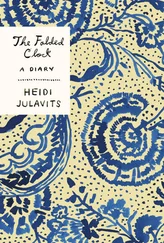Her face, however, did not belong to Irenke.
I couldn’t watch what happened next, but this seemed worse than cowardly. I forced myself to stare at that burning ball, I forced myself to watch as my mother climbed to the edge of the basket, stared down at my red ocean, and jumped.

Here is what I learned in bed.
The Danube flows through, and partially forms the borders of, ten countries.
After a serious illness, Goya spent five years recuperating and reading French revolutionary philosophers, in particular Rousseau, who taught him that imagination divorced from reason produces monsters.
There are such things as irregular flowers.
I also learned that there’d been a spate of surgical impersonator sightings in European cities such as Paris and Düsseldorf, and that plastic surgeons had been asked to report to the authorities patients who approached them with “unrealistic” plastic surgery goals.
Things I did not learn in bed. I did not learn how I was moved to the top floor of the Goergen where, it turned out, the keypass-only medical facilities were located, and which included a hallway of private recovery rooms and a vast surgical theater. I did not learn the name of the specialist who attended me, a formal man whose hospital jacket had been tailored to fit his wide shoulders and narrow waist (in those first hazy days, I thought my pulse was being monitored by a waiter in a white tuxedo), and who did not speak English. I did not learn the name of the pills given to me, sapphire blue capsules that, when left for too long on the white napkin that covered my bed tray, stained the fabric red. I did not learn how I’d acquired a hand-shaped burn on my face, one that spanned the precise spot I’d been touched, during my trip to the Paris hotel lobby, by Madame Ackermann.
When Marta came to visit, she encouraged me not to think about the incident with the balloon basket.
“We have a saying,” she said. “The wound heals better without the fork.”
When Alwyn came to visit, I told her that Marta believed I was attacking Madame Ackermann.
“I’m aware,” Alwyn said.
“But I’m not,” I said.
“I wouldn’t blame you if you were,” she hedged.
“And I told Marta that I don’t want to visit Irenke anymore,” I said.
“Don’t worry,” she said. “I know you can’t help yourself.”
Regardless, Alwyn insisted, the counterproductive result of my regressing was this: I’d become sicker than ever.
I couldn’t disagree with her. Since the night of Dr. Papp’s presentation the wolf had returned with a high-wattage vengeance. Every time I closed my eyes. There it was.
“You are your own worst enemy,” Alwyn observed, as a nurse changed my face dressing. “Have you heard of Dr. Kluge? He’s a very famous electrobiologist. He was also once engaged to my mother.”
Dr. Kluge, she informed me, discovered that a stone called quartzite, due to its density and a property called laser-woven particle distribution, prevented the transmission of certain energy frequencies. He’d helped develop a spa facility made of quartzite slabs to block these frequencies; this building was the perfect place to stall the aging process.
“It also works as a treatment for schizophrenics,” she said. “They hear fewer voices when they’re in ‘the bunker.’ ”
I didn’t object to being classified as schizophrenic. In the metaphoric sense of the word, or maybe the literal sense, no one could dispute that I’d become an unwitting ventriloquist for various hostile others.
But for my “wellness purposes,” Alwyn clarified, I’d be unable to psychically reach out to or be reached by Irenke, or Madame Ackermann, or anyone else for that matter. This spa, to which she and Marta proposed I be moved, was, best I could tell, a building-sized version of the Faraday cage that Madame Ackermann kept in her basement.
“Usually there’s a yearlong waiting list,” Alwyn said, “but I’ve arranged with Kluge, because we’ve remained on friendly terms, for you to hop the queue. He guarantees you’ll show measurable improvements within a week.”
Alwyn fiddled with the cord to my blinds, raising and lowering them until the sunlight stopped at my neck, my head decapitated by shadow.
She admitted, then, that she’d taken it upon herself to do a little extra research “for the sake of our work.”
She handed me a glossy fax that persisted, in the annoying manner of faxes, to curl up on itself rather than lay flat, as though protecting its contents from dissemination. I pinned it open on my bed tray. Written in French, it was a bill of sale from a gallery in Paris called Les Einsteins, dated May 1980, and included a photo of the necklace Irenke had been wearing at the Regnor. According to this bill of sale, the purchaser was Dominique Varga.
Which struck me as curious, but not overly. It confirmed what I already knew to be true. The necklace had once belonged to Varga.
But it grew more curious.
The bill of sale split the necklace’s proceeds into various commissions — the finances of Les Einsteins were modeled more on those of a socialist consignment shop than an art gallery — the figures diminishing into smaller and smaller amounts until everyone who’d had any contact with the necklace, it seemed, received a cut, including, almost as an afterthought, the artist herself, whose name was Elizabeth Severn.
This fact did not strike me with the force it might have; the minute dose of morphine my doctor had prescribed protected me from astonishment. Maybe, too, I had already made this connection in some soupy backwater of my brain, but had failed to fish it to the conscious surface.
I saw threads, wet dark threads, swirling and knotting and leading definitively nowhere. My mother had made Irenke’s necklace. This fact did not strike me with the force it might have; the minute dose of morphine my doctor prescribed protected me from astonishment. Maybe, too, I had already made this connection in the swampy backwater of my brain, but had failed to fish it to the conscious surface. Did this mean Irenke had known my mother? Did this prove Irenke was Dominique Varga’s daughter? Perhaps the only thing it proved was that, yes, Irenke had acquired, and possibly stolen, this necklace from Varga, which Varga had bought from my mother.
But whether or not Varga was Irenke’s mother, and whether or not my mother was, in Irenke’s words, “a truly bad person,” well, this necklace illuminated little more on these fronts, save the stark reality that nothing in my life, no object, no person, spun beyond the orbit of gravely, perversely mattering.
Perhaps I should have wondered how Alwyn, while doing “a little research,” had tracked down the one bit of information I’d thus far kept from her — that Varga and my mother had been friends.
I did not wonder.
“Les Einsteins was Varga’s gallery,” Alwyn said. “Maybe Varga was simply a fan of her work. Regardless, I think it’s safe to presume they met each other.”
Beneath her allotted pittance, my mother had signed her name. I traced her handwriting’s erratic and inscrutable leaps. Not to use these letters as a portal, not to go anywhere. I wanted a thing, not a doorway.
“Also,” she said, “I spoke with the gallery owner. I said that he must have found your mother’s work impressive, given he’d agreed to represent her. To which he said, ah .”
I didn’t know what ah meant. I did not want to know.
“Do you think Dominique Varga would have allowed any old person to regress into her past? She knew your mother. Maybe she respected her for being … similarly cutthroat. Whatever the reason, Varga’s partial to you. This is a big advantage we need to exploit. You need to let her use you.”
Читать дальше













